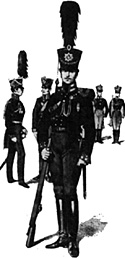The central point of the previous two parts of this article was to show that the generally held view of the state of the "unreformed" army bears little relationship to reality. Moreover, there was little new in the principles of warfare adopted by the "reformed" Prussian army in the later part of the Napoleonic Wars and the noted military historian Siegfried Fiedler makes this very point in his volume Napoleon gegen Preussen (pp.52):
- The right path had been shown (i.e. before 1807), that is in the sense that the Prussian infantry developed skirmish tactics more systematically than the French. In any case, in the period of reform after 1807, they needed only to progress on the principles already existing.
 The Reformers, men like Scharnhorst and Gneisenau had held posts prior to 1807 from which they were able to exercise a degree of influence on the type of warfare in which the army engaged. They were, however, only a small group and did little to alter the fabric of the army to a radical degree. Their attempts were often too little and too late, such as Scharnhorst's demands to organize the army into mixed divisions of all arms.
The Reformers, men like Scharnhorst and Gneisenau had held posts prior to 1807 from which they were able to exercise a degree of influence on the type of warfare in which the army engaged. They were, however, only a small group and did little to alter the fabric of the army to a radical degree. Their attempts were often too little and too late, such as Scharnhorst's demands to organize the army into mixed divisions of all arms.
At right, GUARD JAEGER 1808. Source- Geschichte des
Garde-Jaeger-Batallions 1808-1888 by von Rentzell (Berlin 1889).
The bulk of the army was only thus organized on mobilization against France in 1806 and did not have the proper command system to correctly utilize this formation and to co-ordinate its constituent parts. It was indeed possible to create divisions, but the experience in their
use could not be conjured up. Simply imitating the French system often did much more harm than good when what the Prussians really needed was to develop their own system. As Gneisenau said in his Memorandum on the War of 1806:
Reforming the army was thus not simply to be accomplished by copying the French system-what was needed was to modernize and develop the existing Prussian system.
The defeats of 1806 and 1807 elevated the Reformers into a position of predominance in the army because the leaders of this group had acquitted themselves admirably in those campaigns when the army as a whole had performed dismally. Scharnhorst's bravery on the field of battle had shown him to be more than a mere pen-pushing theoretician, Gneisenau's determined defense of Colberg thrust him into the limelight; Bluecher, renowned for his spirited retreat to Luebeck added by vocal support his prestige to the Reform Movement. The Reformers had for a time the upper hand, but their wishes and plans were often frustrated by French suspicions and domestic
conservatism.
The reforms affected the entire structure of the state, the nature of society was altered, the administration modernized and the army reorganized. The reforms which most affected the tactical use of the infantry were:
The reforms will be examined in turn.
This article appears in MagWeb (Magazine Web) on the Internet World Wide Web.. . . those practices of the French that were imitated were exactly those should have been avoided, such as dividing the army into divisions without considering that there were not enough generals capable of commanding them . . .
Back to Table of Contents -- Courier Vol. IV No. 2
© Copyright 1982 by The Courier Publishing Company.
Other military history articles and gaming articles are available at http://www.magweb.com